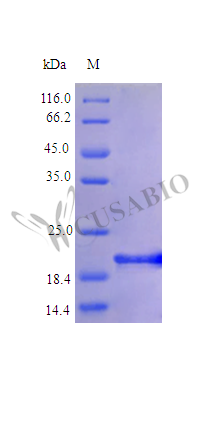Producing recombinant human IL6 in E. coli involves cloning the gene that encodes the 30-212aa of the human IL6 into an expression vector, which is transformed into E. coli cells. The cells are cultured under conditions that promote protein expression. After reaching adequate growth, the cells are lysed to release the recombinant IL6 protein. The obtained recombinant IL6 protein is purified by affinity chromatography. The purity of the IL6 protein is confirmed using SDS-PAGE, exceeding 96%. Its endotoxin content is less than 1.0 EU/μg as determined by the LAL method. This recombinant mouse IL6 protein has been validated to be active. Cell proliferation assays are performed to verify the protein's activity, ensuring its functional integrity post-purification.
IL6 acts in an autocrine manner to regulate basal cellular functions in human endothelial cells [1]. It is implicated in cell cycle regulation, signaling, and cellular movement [1]. IL6 also modulates gene expression in cellular responses mediated by cytokines and bacterial infections [2]. Studies have shown that IL6 is essential for pancreatic cancer progression by promoting MAPK signaling activation and oxidative stress resistance [3].
IL6 has been shown to induce a signaling loop that activates the canonical WNT signaling pathway in pathological conditions, suggesting its potential as a target for diseases like rheumatoid arthritis and certain cancers [4]. IL6 autoantibodies are associated with the pathogenesis of type 2 diabetes [5]. Furthermore, IL6 is involved in inflammatory responses and metabolism [5]. It synergistically activates the transcription of inflammatory cytokines like interleukin-8 in conjunction with other transcription factors like NF-kappa B [6].
References:
[1] L. Ljungberg, M. Zegeye, C. Kardeby, K. Fälker, D. Repsilber, & A. Sirsjö, Global transcriptional profiling reveals novel autocrine functions of interleukin 6 in human vascular endothelial cells, Mediators of Inflammation, vol. 2020, p. 1-12, 2020. https://doi.org/10.1155/2020/4623107
[2] Y. Yang, V. Tesmer, & M. Bina, Regulation of hiv-1 transcription in activated monocyte macrophages, Virology, vol. 299, no. 2, p. 256-265, 2002. https://doi.org/10.1006/viro.2001.1530
[3] Y. Zhang, W. Yan, M. Collins, F. Bednar, S. Rakshit, B. Zetteret al., Interleukin-6 is required for pancreatic cancer progression by promoting mapk signaling activation and oxidative stress resistance, Cancer Research, vol. 73, no. 20, p. 6359-6374, 2013. https://doi.org/10.1158/0008-5472.can-13-1558-t
[4] M. Katoh and M. Katoh, Stat3-induced wnt5a signaling loop in embryonic stem cells, adult normal tissues, chronic persistent inflammation, rheumatoid arthritis and cancer (review), International Journal of Molecular Medicine, 2007. https://doi.org/10.3892/ijmm.19.2.273
[5] K. Fosgerau, P. Galle, T. Hansen, A. Albrechtsen, C. Rieper, B. Pedersenet al., Interleukin-6 autoantibodies are involved in the pathogenesis of a subset of type 2 diabetes, Journal of Endocrinology, vol. 204, no. 3, p. 265-273, 2009. https://doi.org/10.1677/joe-09-0413
[6] T. Matsusaka, K. Fujikawa, Y. Nishio, N. Mukaida, K. Matsushima, T. Kishimotoet al., Transcription factors nf-il6 and nf-kappa b synergistically activate transcription of the inflammatory cytokines, interleukin 6 and interleukin 8., Proceedings of the National Academy of Sciences, vol. 90, no. 21, p. 10193-10197, 1993. https://doi.org/10.1073/pnas.90.21.10193






